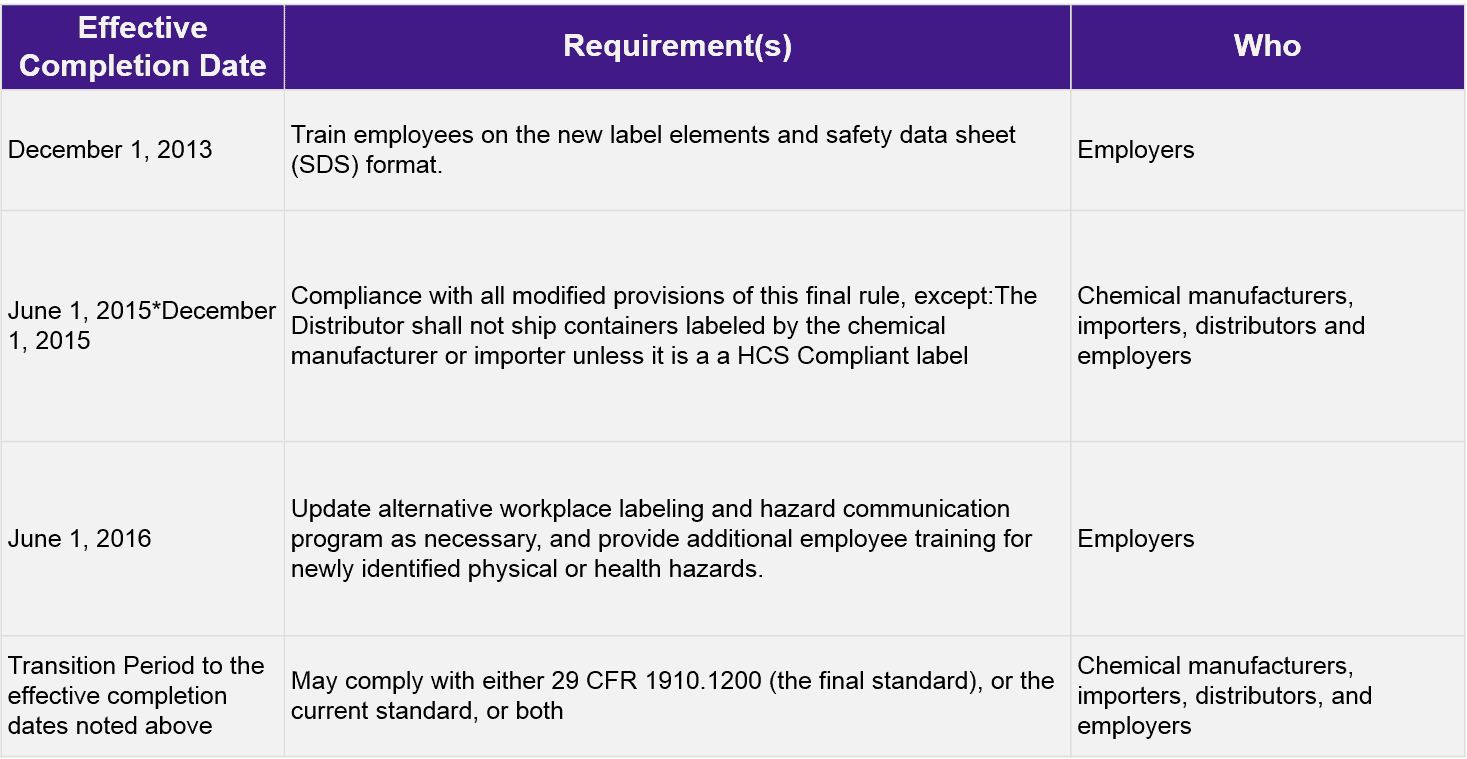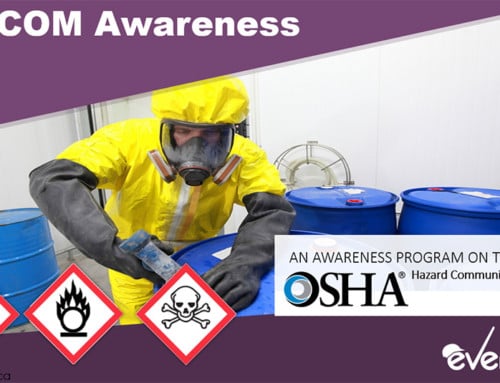OSHA’s Hazard Communication Standard
The Occupational Safety and Health Administration (OSHA) has aligned its Hazard Communication Standard (also called HCS) with Globally Harmonized System of Classifying and Labeling Chemicals (GHS). As a result, the old HCS (HazCom 1983) has been updated to the new HCS (HazCom 2012).
While the old HCS required chemical manufacturers, importers, and suppliers to provide hazard information to workers and employers by adding labels on chemical containers and creating safety data sheets, it did not provide clear and harmonized criteria for providing the information. Therefore, chemical manufacturers and suppliers classified chemicals and provided hazard information in whatever formats they chose, resulting in frequent hazard communication problems and workplace injuries.
With HazCom 2012, however, a single set of harmonized criteria for chemical classification and hazard communication has been provided, resulting in a common and more coherent approach to chemical classification, labeling, and preparation of safety data sheets.
The Globally Harmonized System: What Is It?
The Globally Harmonized System (GHS) is a negotiated and internationally agreed-upon approach to classifying and labeling chemicals. It provides standardized classification criteria for physical hazards, health hazards, and environmental hazards of different chemicals. It also standardizes the approach to labeling elements, preparing safety data sheets and communicating hazards to workers.
The GHS is a product of negotiations between hazard communication experts from different countries, stakeholder groups and international organizations, and helps to eliminate trade and hazard communication barriers between American and foreign businesses dealing in hazardous chemicals while enhancing safety and health protection for America’s workers.

Why Did OSHA Modify the Hazard Communication Standard
In 2012, OSHA updated the Hazard Communication Standard by adopting GHS in order to enhance the workplace health and safety through better communication of chemical hazards.
Since its introduction in 1983, HCS has ensured that employers and employees receive extensive information regarding the chemicals they handle, use and store in their workplaces. As a performance-oriented standard, HCS 1983 required manufacturers and importers of hazardous chemicals to provide hazard information through labels and via material safety data sheets (MSDSs), leading to improved workplace safety and health.
Nevertheless, the old HCS (HCS 1983) allowed the manufacturers and importers to provide the information in whatever system they chose, resulting in communication gaps that created some room for workplace exposures and injuries.
For instance, because the US is both a major exporter and importer of chemicals, workers in America frequently see and handle labels and SDSs from different countries whose chemical classification, labeling and SDS requirements are often different or conflicting with the requirements in the United States.
This often creates confusion especially when safety data sheets and labels include hazard statements and symbols that are not well understood or unfamiliar to the workers. Similarly, problems may arise when labels contain so much information that crucial statements are not easy to recognize.
In contrast, the adoption of GHS eliminates differences in hazard classification criteria and ensures that chemicals imported or exported from the US have consistent information, hence improving hazard communication.
The updated Hazard Communication Standard is a more effective approach to classification of hazards and conveying information in workplaces. It includes detailed criteria for determination of the hazardous effects of chemicals and offers standardized label elements for different hazard categories and classes.
In fact, HazCom 2012 enhances employer and worker comprehension of hazards, ensures safe handling and use of chemicals, offers a standardized format for Safety Data Sheets and provides a harmonized criteria for safety data sheet and label design, which enable employers, workers, emergency responders and health professionals to access hazard information more effectively and efficiently.
Core Revisions of OSHA’s Hazard Communication Standard
Hazard Classification: HazCom 2012 offers specific criteria for addressing the classes, categories, and physical and health hazards. Chemical manufacturers and suppliers are required to identify hazards of chemicals imported or produced and to classify them appropriately. The new classification criteria ensures consistency across manufacturers and guarantees that safety data sheets and labels are accurate.
Labels: HazCom 2012 requires chemical importers and manufacturers to provide labels that include a standardized signal word, pictogram, precautionary statement and hazard statement for every hazard category and class.
Safety Data Sheets: HazCom 2012 requires safety data sheets with a clear 16-section format, ensuring consistency in the presentation of crucial protection information.
Information and Training: The updated HCS recognizes training as a core aspect of effective hazard communication. Therefore, the new standard requires that workers are trained on new label and new safety data sheet format by December 1, 2013 (or re-trained within 2 years after the final rule is published), in addition to current training requirements.
Similarities and Differences between the Old HCS and New HCS
The new HCS (HazCom 2012) is simply a modification of the previous standard. Therefore, parts of HCS 1983 which were not related to the GHS, like the basic framework, scope and exemptions, have remained largely unchanged.
However, there have been slight modifications on terminology to make the revised HCS to meet the language of the GHS. For instance, the term “material safety data sheet” has been modified to “safety data sheet” while the term “hazard determination” has been modified to “hazard classification”.
While both the old and the new HCS require that chemical hazard evaluation must be based on existing scientific evidence relevant to such hazards, there are slight differences in chemical hazard evaluation between the old and the modified HCS.
For instance, in the old HCS, the hazard evaluation is performance-oriented and based on hazard definitions, which are neither specific nor detailed criteria. In fact, the old HCS only requires the hazard evaluator to determine whether available chemical data meet certain hazard definitions.
In contrast, HazCom 2012 has specific and detailed criteria for every physical and health hazard and provides detailed instructions on hazard evaluation and classification, and determination of whether substances or mixtures are covered. Besides, it has hazard classes which are further sub-divided into categories as a reflection of the severity of the effects of the chemicals.
Phase-in Period for the Updated Hazard Communication Standard
December 1, 2013: Employers are expected to train employees on revised label elements and new safety data sheet format by this date.
June 1, 2015: Chemical manufacturers, importers, suppliers and employers should comply with all the revised provisions, except the ones provided for later dates.
December 1, 2015: Distributors must only ship chemical containers with GHS labels. All manufacturers and importers expected to use GHS labels on their products.
June 1, 2016: Employers must update their workplace labeling system and hazard communication programs, and provide additional worker training on newly identified physical and health hazards by this date.
During the transition to the revised Hazard Communication Standard, employers are required to comply with either the old or new HCS or even both of them. However, during the transition period, workers must be trained on new label elements (pictograms, signal words, precautionary statements and hazard statements) and SDS format so that they are able to handle HazCom 2012 labels and SDSs.
It is also critical that workers are exposed to new labels and the new SDSs in their workplaces so they are familiar with them, learn to use them and understand how to access information from them effectively.







